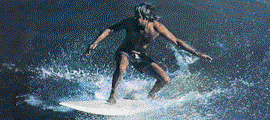The 1930’s and 40’s were a ground breaking period in the history of surfing innovation. People were getting in the water more thanks to Blake’s lightweight finned boards.
Inspired byBlake’s innovative designs, a group of Hawaiian surfers, Fran Heath, Wally Froseith and John Kelly experimented with shaping and tail sizes. By shaving off parts of the tail and rails, a steep contoured Roll/Vee tail was crafted, allowing more control and maneuverability. This board the ‘Hot Curl’ finally allowed surfer to ride in the ‘hot curl’, or curling peak of the wave.
From 1932, redwood was largely partnered with the South American balsa wood. A super lightweight alternative to redwood; balsa boards were coated in varnish to waterproof. The centre of the boards was balsa and the rails, redwood to ensure strength and durability. And then it happened. World War II finished and technology had advanced, new fibreglass, plastics and Styrofoam materials became easily accessible for shapers – resulting in a revolution.
The fibreglass revolution is said to be started by Pete Peterson in 1946, who crafted a hollow plastic board with a redwood stringer down the middle, and coated in fibreglass.

John Kelly,Wally Froiseth and George Downing/ Gary Lynch Surfer Magazine
This was followed in 1949 when surf icon Bob Simmons created the ‘sandwich’, a Styrofoam core board, with a plywood case, balsa wooden rails and coated in fibreglass.&n
Bob Simmons' 'sandwich' is credited for starting a new revolution, the popularisation of 'Mini Simmons' boards that have spread like wildfire in recent years. Mini Simmons 'funboards' are, as the name suggests, designed with similar specs to Simmons' sandwich and have immortalised the early fibreglass designs. Mini Simmons are super short, flat and wide, making for a super fun ride.
 Disrupt Mini Simmons
Disrupt Mini Simmons
Check out our selection of Mini Simmons boards or customize your own! Read our next installment of the History Of Surfing Innovation – Part 4: Let's Go Surfing!

